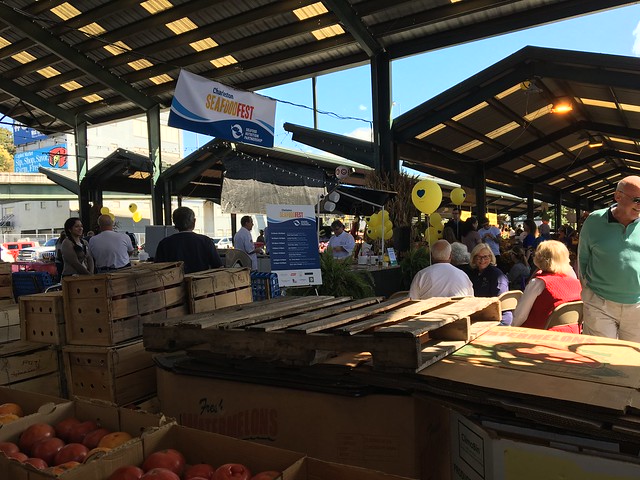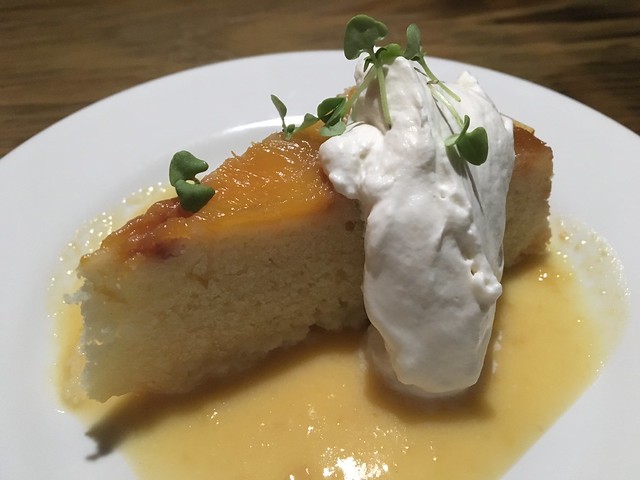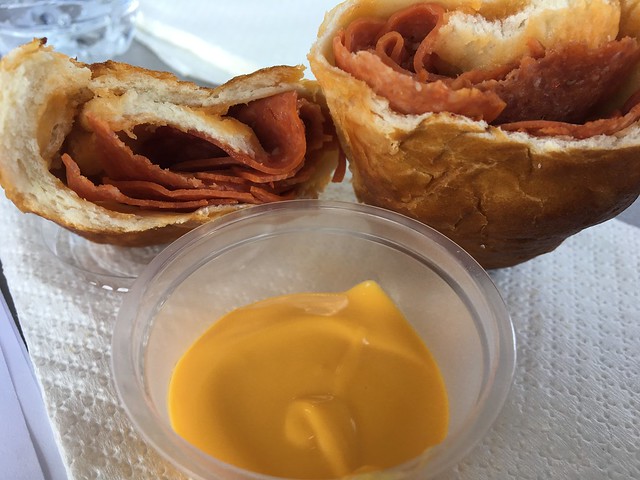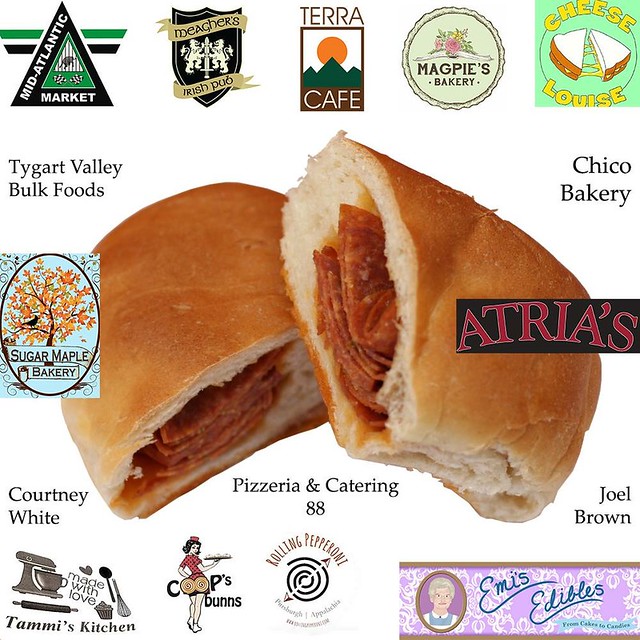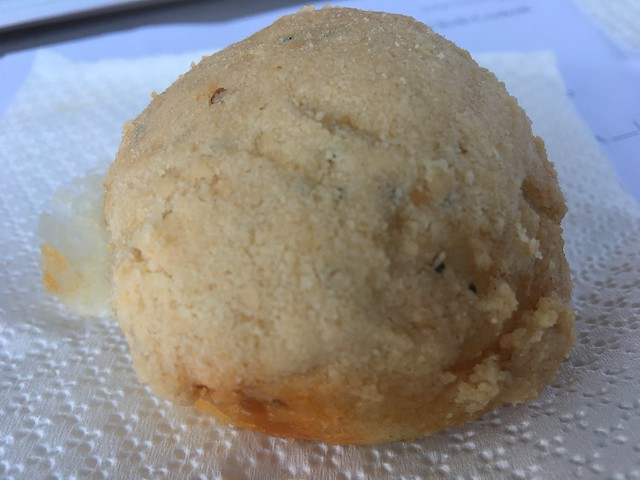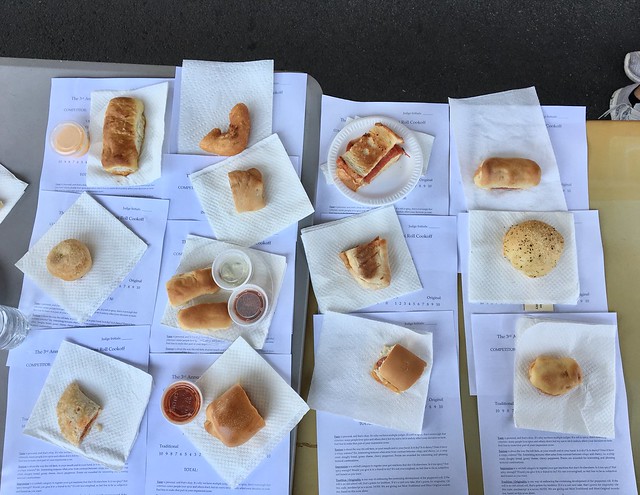
If you grew up with your grandma or great-grandma making bread in West Virginia, there’s a good chance it was salt rising bread.
Don’t let the name fool you – there’s no salt in this bread. And, there’s no yeast.
This dense white bread is an Appalachian creation that doesn’t rely on yeast to rise. Yeast, which was likely only found at a brewery in the 18th or 19th century, may have been difficult to come by in rural areas during the early pioneer days. Innovative women likely crafted this recipe out of necessity or happenstance.
Salt rising bread instead relies upon the bacteria in potatoes or cornmeal and flour that goes into the starter in order to rise. The exact science of this bread is a bit shrouded in mystery, but time and temperature are key variables in the process – a lot of both.
As for the name “salt rising bread” – which has little to no salt in the recipe – there are a few theories: that in the early days, women kept the starter dough warm by placing it in the salt barrel on top of the wagon wheel while they traveled, and that was warmed by the sun. Another is that the starter was surrounded by rock salt that was kept warm on the hearth. And, yet another is that it’s an evolution of the word “saleratus,” which was an ingredient used in the early recipes prior to baking soda.
Whatever the origin, it’s a tradition that has been passed down through generations in Appalachia, though very few people continue to make the bread in this authentic way today.
Jenny Bardwell and Susan Brown, authors of Salt Rising Bread: Recipes and Heartfelt Stories of a Nearly Lost Appalachian Tradition, are working to keep the craft alive and document its history.
Bardwell, proprietor of Rising Creek Bakery in Mt. Morris, Pa. which specializes in salt rising bread, and Brown, who is the founded of The Salt Rising Bread Project website, traced salt rising bread’s history and found the earliest recipe they found for “Salt Risen Bread” comes from West Virginia in 1778.
“The pioneer women who discovered that they could ‘raise’ bread dough without yeast may not have understood how it happened, but they seized the moment and repeated the process until they perfected it. And they shared,” the co-authors wrote in their book.
Bardwell and Brown are sharing their knowledge with others through classes at the bakery have taken it upon themselves to be the “chroniclers and preservers” of this nearly lost tradition.
“I’m devoted to this bread because I learned it from my grandmother, and it has been in my family for generations, and it’s a precious tradition that I don’t want to lose,” Brown said. “This is our heritage, and it was made by these Appalachian women who didn’t have another way to make bread so they relied on their ingenuity and resourcefulness, and I think it’s important to keep that spirit alive.”
Brown said so few people make this traditional bread anymore for a few reasons.
“One, it can be tricky and two, it’s very time consuming. It’s a lot of hours to be at home and make sure you’re there to tend to it. And, many women are working full time and aren’t home like they used to be. So, the tradition – which had been handed down through families – is being lost, and that’s why it’s important to keep it alive however we can,” she said.
Those who grew up with the bread long for that cheese-like flavor and fine crumbly texture. Those who aren’t as familiar often scrunch their noses up at the microbial bread’s distinct smell but fall in love at first bite.
This bread is much like our region – steeped in tradition and resourceful. It’s these qualities that help define Appalachia, and paying homage to these traditions helps keep our history alive.
The Appalachian bread is important in our state’s culinary history, and through devotees like Bardwell and Brown, this tradition will not be lost.
SALT RISING BREAD RECIPES
While Bardwell and Brown collected 150-200 salt rising bread recipes, most of them fell into two categories: the cornmeal & flour method or the potato method.
Both of the below recipes are featured in “Salt Rising Bread: Recipes and Heartfelt Stories of a Nearly Lost Appalachian Tradition” and were the ones the authors learned from.
Pearl Haines’s Salt Rising Bread Recipe
Ingredients:
1/2 cup scalded milk
3 teaspoons cornmeal
1 teaspoon flour
1/8 teaspoon baking soda
Preparation:
1. Pour milk onto dry ingredients and stir.
2. Keep warm overnight until foamy.
3. After the raisin’ has foamed and has a rotten cheese smell, in a medium-sized bowl add 2 cups of warm water to mixture, then enough flower (about 1½ cups) to make like a thin pancake batter. Stir and allow to rise again until it becomes foamy. This usually takes about 2 hours.
4. Next, add 1 cup of warm water for each loaf of bread you want to make, up to 6 loaves (e.g., 6 cups of water makes 6 loaves of bread). Add enough flour (20 cups for 6 loaves or about one 5 pound bag of flour plus 1/3 bag of flour). Form into loaves and grease tops. Let loaves rise in greased pans for 1.5 to 3 hours – sometimes longer if it is a cold day.
5. Bake at 350 degrees for 35 to 45 minutes or until loaves sound hollow when tapped.
Katheryn Rippetoe Erwin’s Salt Rising Bread
Ingredients:
1 medium Irish potato, sliced and placed in a jar
ADD: 1 tablespoon cornmeal
¼ teaspoon soda
¼ teaspoon salt
2 cups boiling water
Preparation:
1. Cover and let rise in a warm place until morning. (I set mine on top of the pilot light on my hot water tank). If the mixture is foamy and has the salt rising bread “aroma” the next morning, pour off the liquid and throw away the potatoes.
2. Mix 2 cups of very warm water with ½ cup of shortening. Then add 1 teaspoon salt, 4 teaspoons sugar, and 5 cups flour. Combine with rising mixture (starter) to make a stiff batter. Let this rise until double in bulk.
3. Work in 6 cups of flour, to make a soft dough. Divide into 3 portions. Let rise 10 minutes. Knead for 3 minutes. Place in 3 greased pans. Let rest until dough reaches the top of the pan.
4. Bake at 450 degrees for 15 minutes, then at 400 degrees for 25 minutes.
-->
Don’t let the name fool you – there’s no salt in this bread. And, there’s no yeast.
This dense white bread is an Appalachian creation that doesn’t rely on yeast to rise. Yeast, which was likely only found at a brewery in the 18th or 19th century, may have been difficult to come by in rural areas during the early pioneer days. Innovative women likely crafted this recipe out of necessity or happenstance.
Salt rising bread instead relies upon the bacteria in potatoes or cornmeal and flour that goes into the starter in order to rise. The exact science of this bread is a bit shrouded in mystery, but time and temperature are key variables in the process – a lot of both.
As for the name “salt rising bread” – which has little to no salt in the recipe – there are a few theories: that in the early days, women kept the starter dough warm by placing it in the salt barrel on top of the wagon wheel while they traveled, and that was warmed by the sun. Another is that the starter was surrounded by rock salt that was kept warm on the hearth. And, yet another is that it’s an evolution of the word “saleratus,” which was an ingredient used in the early recipes prior to baking soda.
Whatever the origin, it’s a tradition that has been passed down through generations in Appalachia, though very few people continue to make the bread in this authentic way today.
Jenny Bardwell and Susan Brown, authors of Salt Rising Bread: Recipes and Heartfelt Stories of a Nearly Lost Appalachian Tradition, are working to keep the craft alive and document its history.
Bardwell, proprietor of Rising Creek Bakery in Mt. Morris, Pa. which specializes in salt rising bread, and Brown, who is the founded of The Salt Rising Bread Project website, traced salt rising bread’s history and found the earliest recipe they found for “Salt Risen Bread” comes from West Virginia in 1778.
“The pioneer women who discovered that they could ‘raise’ bread dough without yeast may not have understood how it happened, but they seized the moment and repeated the process until they perfected it. And they shared,” the co-authors wrote in their book.
Bardwell and Brown are sharing their knowledge with others through classes at the bakery have taken it upon themselves to be the “chroniclers and preservers” of this nearly lost tradition.
“I’m devoted to this bread because I learned it from my grandmother, and it has been in my family for generations, and it’s a precious tradition that I don’t want to lose,” Brown said. “This is our heritage, and it was made by these Appalachian women who didn’t have another way to make bread so they relied on their ingenuity and resourcefulness, and I think it’s important to keep that spirit alive.”
Brown said so few people make this traditional bread anymore for a few reasons.
“One, it can be tricky and two, it’s very time consuming. It’s a lot of hours to be at home and make sure you’re there to tend to it. And, many women are working full time and aren’t home like they used to be. So, the tradition – which had been handed down through families – is being lost, and that’s why it’s important to keep it alive however we can,” she said.
Those who grew up with the bread long for that cheese-like flavor and fine crumbly texture. Those who aren’t as familiar often scrunch their noses up at the microbial bread’s distinct smell but fall in love at first bite.
This bread is much like our region – steeped in tradition and resourceful. It’s these qualities that help define Appalachia, and paying homage to these traditions helps keep our history alive.
The Appalachian bread is important in our state’s culinary history, and through devotees like Bardwell and Brown, this tradition will not be lost.
SALT RISING BREAD RECIPES
While Bardwell and Brown collected 150-200 salt rising bread recipes, most of them fell into two categories: the cornmeal & flour method or the potato method.
Both of the below recipes are featured in “Salt Rising Bread: Recipes and Heartfelt Stories of a Nearly Lost Appalachian Tradition” and were the ones the authors learned from.
Pearl Haines’s Salt Rising Bread Recipe
Ingredients:
1/2 cup scalded milk
3 teaspoons cornmeal
1 teaspoon flour
1/8 teaspoon baking soda
Preparation:
1. Pour milk onto dry ingredients and stir.
2. Keep warm overnight until foamy.
3. After the raisin’ has foamed and has a rotten cheese smell, in a medium-sized bowl add 2 cups of warm water to mixture, then enough flower (about 1½ cups) to make like a thin pancake batter. Stir and allow to rise again until it becomes foamy. This usually takes about 2 hours.
4. Next, add 1 cup of warm water for each loaf of bread you want to make, up to 6 loaves (e.g., 6 cups of water makes 6 loaves of bread). Add enough flour (20 cups for 6 loaves or about one 5 pound bag of flour plus 1/3 bag of flour). Form into loaves and grease tops. Let loaves rise in greased pans for 1.5 to 3 hours – sometimes longer if it is a cold day.
5. Bake at 350 degrees for 35 to 45 minutes or until loaves sound hollow when tapped.
Katheryn Rippetoe Erwin’s Salt Rising Bread
Ingredients:
1 medium Irish potato, sliced and placed in a jar
ADD: 1 tablespoon cornmeal
¼ teaspoon soda
¼ teaspoon salt
2 cups boiling water
Preparation:
1. Cover and let rise in a warm place until morning. (I set mine on top of the pilot light on my hot water tank). If the mixture is foamy and has the salt rising bread “aroma” the next morning, pour off the liquid and throw away the potatoes.
2. Mix 2 cups of very warm water with ½ cup of shortening. Then add 1 teaspoon salt, 4 teaspoons sugar, and 5 cups flour. Combine with rising mixture (starter) to make a stiff batter. Let this rise until double in bulk.
3. Work in 6 cups of flour, to make a soft dough. Divide into 3 portions. Let rise 10 minutes. Knead for 3 minutes. Place in 3 greased pans. Let rest until dough reaches the top of the pan.
4. Bake at 450 degrees for 15 minutes, then at 400 degrees for 25 minutes.
All work property of Candace Nelson. Powered by Blogger.

